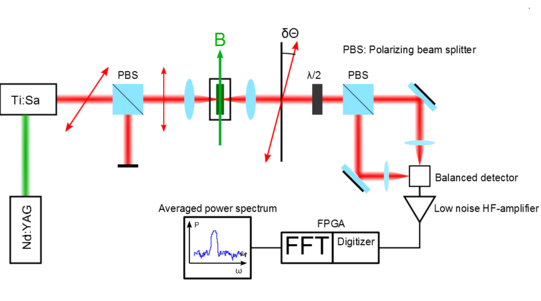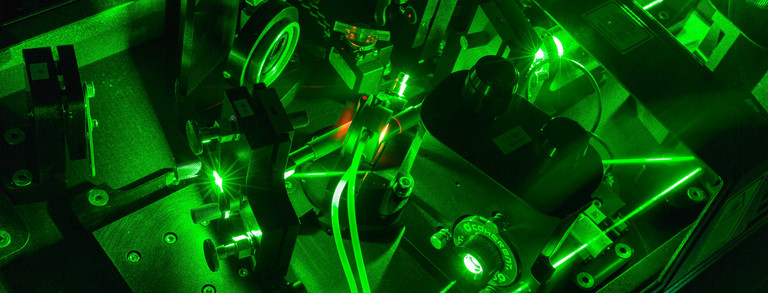Spin Noise Spectroscopy
Description of the Research
Idea and background
The fluctuation-dissipation theorem marks the origin of spin noise spectroscopy: as long as displacements from equilibrium are sufficiently small, the relaxation dynamics of a spin system are dictated by it's linear response function, regardless of the source of excitation. This implies two ways of measurement. The common method is pump-probe spectroscopy, where the spin system is driven away from equilibrium by a pump laser, and the subsequent relaxation back to the ground state is observed by a weaker probe laser. Such techniques are widely used at Experimental Physics II.
Spin noise spectroscopy relies on the existence of nonzero temporal fluctuations of spin magnetization. These arise spontaneously in time, and the system responds with the same linear dynamics as in the first case. Thus by carefully listening to the spin noise, one can in principle obtain spin dynamics from fluctuations alone. Such an approach especially offers the advantage to perform studies in or at least close to thermal equilibrium.
Spin noise imparts proportional noise on the Faraday rotation of a linearly polarized probe laser beam, and can therefore be measured and analyzed with optical means. Research at Experimental Physics II covers investigations on a wide range of materials, such as bulk solid state systems, semiconductor nanostructures or classical atomic gases.
Experimental technique and setup
Optical spectroscopy of spin noise requires stable lasers. At Experimental Physics II we basically use a single frequency Ti:Sapphire ring laser. The Faraday rotation noise is measured with a common polarimeter, as it is used for pump probe measurements also. Detection occurs with a wideband balanced photoreceiver. Its output signal is amplified and then digitized. The spectra are gained from FFT of this digitized signal. As the spin noise contribution to the overall detector shot noise is usually very small, fast and efficient averaging is desirable to achieve suitable signal to noise-ratios (SNR): overall bandwidths between 200 MHz and 1 GHz can be efficiently covered with a digitizer that incorporates FPGA technology. For even smaller bandwidths, a conventional high-speed digitizer is used in combination with multicore FFT computation.

Completed projects and recent results
Polarimetric sensitivity enhancement, and spin noise spectroscopy at high probe laser intensities
In this project attention was attracted to the fact that the ultimate (shot-noise-limited) polarimetric sensitivity can be enhanced by orders of magnitude leaving the photon flux incident onto the photodetector on the same low level. This opportunity is of crucial importance for present-day spin noise spectroscopy, where a direct increase of sensitivity by increasing the probe beam power is strongly restricted by the admissible input power of the broadband photodetectors. The gain in sensitivity was achieved by replacing the commonly used polarimetric detection schemes with balanced detectors by geometries with stronger polarization extinction. The efficiency of these high-extinction polarization geometries with enhancement of the detected signal by more than an order of magnitude was demonstrated by measurements of the spin noise spectra of bulk n-GaAs in the spectral range 835–918 nm. It could be shown that the inevitable growth of the probe beam power with the sensitivity gain makes spin noise spectroscopy much more perturbative, but, at the same time, opens up fresh opportunities for studying nonlinear interactions of strong light fields with spin ensembles.
Two-colour correlation spin noise spectroscopy in quantum dot ensembles
Spin noise spectroscopy usually measures intrinsic spin fluctuations. This study showed that correlations in these fluctuations can be further exploited in multi-probe noise studies to reveal information that in general cannot be accessed by conventional linear optical spectroscopy, such as the underlying homogeneous linewidths of individual constituents within inhomogeneously broadened systems. This is demonstrated in singly charged (In,Ga)As quantum-dot ensembles using two weak probe lasers: When the lasers have similar wavelengths, they probe the same quantum dots in the ensemble and show correlated spin fluctuations. In contrast, mutually detuned probe lasers measure different subsets of quantum dots, giving uncorrelated fluctuations. The noise correlation versus laser detuning directly reveals the quantum dot homogeneous linewidth even in the presence of a strong inhomogeneous broadening. Such noise-based correlation techniques are not limited to semiconductor spin systems, but are applicable to any system with measurable intrinsic fluctuations.
Spin noise spectroscopy involving RF magnetic fields to go beyond the restrictions of thermal equilibrium and linear response
Per the fluctuation-dissipation theorem, the information obtained from spin noise studies in thermal equilibrium is necessarily constrained by the system’s linear response functions. However, by including weak radio frequency magnetic fields, it could be demonstrated that intrinsic and random spin fluctuations even in strictly unpolarized ensembles can reveal underlying patterns of correlation and coupling beyond linear response, and can be used to study nonequilibrium and even multiphoton coherent spin phenomena. This capability was demonstrated in a study on a classical vapor of potassium atoms, where spin fluctuations alone directly revealed Rabi splittings, the formation of Mollow triplets and Autler-Townes doublets, AC Zeeman shifts, and even nonlinear multiphoton coherences.
Influence of the nuclear quadrupole interaction on electron and hole spin dephasing in quantum dot ensembles
This project focused on theory: the real-time spin dynamics and the spin noise spectra are calculated for p and n-charged quantum dot ensembles within an anisotropic central spin model, that is extended by additional nuclear electric quadrupolar interactions (QC) and augmented by experimental data. Using realistic estimates for the distribution of hyperfine coupling constants including an anisotropy parameter, it is shown that the characteristic long time scale of the central spin dephasing is of the same order for electron and hole spins. In particular, the dephasing is strongly determined by the QC, even though the analytical form of the spin decay differs significantly - which is consistent with experimental measurements. The low frequency part of the electron spin noise spectrum is approximately 1/3 smaller than that of hole spins as a consequence of the spectral sum rule and the different spectral shapes. This is confirmed by experimental spectra measured on both types of quantum dot ensembles in the low power limit of the probe laser.
Current Offers For Bachelor-, Master- or PhD-Theses
Bachelor-, Master- and PhD candidates are highly welcome to join our team. Please don't hesitate to contact us!
Contact
- PD Dr. Alex Greilich
- Alexandr Kamenskii
- Clara Rittmann
Collaborations
- National High Magnetic Field Laboratory, Los Alamos NM, USA
- St. Petersburg State University, St. Petersburg, Russia
- Ioffe Physical-Technical Institute, St. Petersburg, Russia



